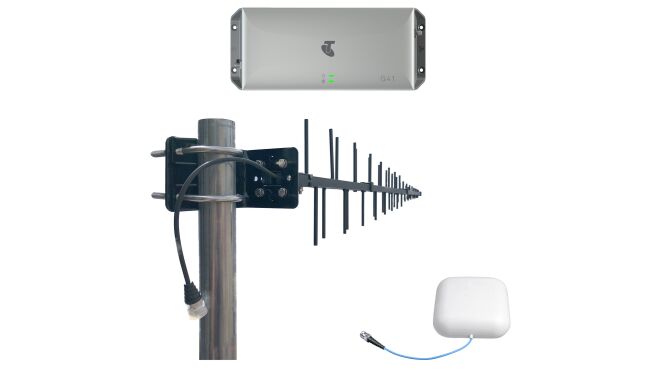Mobile Signal Repeater System
Its best for you to first read the link from ACMA by clicking here before you read on
There are many types but what is best for the job is the question.
There is only one problem.
Is the device a "cellular mobile repeater" or a "mobile phone booster" as the ACMA State.
Sometimes the terms ‘cellular mobile repeater’ and ‘mobile phone booster’ are used interchangeably. However, they are different devices.
Cellular mobile repeaters: communicate with multiple handsets using radiofrequency energy.
Mobile phone boosters: use a wired connection to a single mobile handset.
Mobile phone boosters are prohibited items. It is illegal to own, use or supply a mobile phone booster in Australia.
Equipment like

is a "Cellular Mobile Repeater"
But it also comes to how its installed too as in this photo show the right and wrong ways its installed.

Then the more fun is the provider you want to connect to, like here in Australia there is only 3 full providers Telstra, Optus & Vodafone*, these network providers supply to many other mobile phone companies.
(* Vodafone is in some places piggy backing off some Telstra and Optus to give better reach.)
Once you know who is the network provider (like here we will use Telstra) then you need to look into the area (House) that its going to be installed in and where is the closes network provider Base Station and then what frequency they are using as there is so many and and if the Repeater will support it.
Telstra like all others now, now only support 4G & 5G (as all the the older ones are not in use these days) ,
so for T, 4G there is:
| Telstra 4G | Telstra 5G | Optus 4G | Optus 5G | Vodafone 4G | Vodafone 5G |
| 700MHz (B28) | 850MHz (n5) | 700MHz (B28) | 2100MHz (n1) | 850MHz (B5) | 700MHz (n28) |
| 900MHz (B8) | 3500MHz (n78) | 1800MHz (B3) | 2300MHz (n40) | 1800MHz (B3) | 850MHZ (n5) |
| 1800MHz (B3) | 26GHz (n258) | 2100MHz (B1) | 3500MHz (n78) | 2100MHz (B1) | 1800Hz (n3) |
| 2100MHz (B1) | 2300MHz (B40) | 26GHz (n258) | 2600Mhz (B7) | 3500MHz (n78) | |
| 2600MHz (B7) | 2600MHz (B7) | 26GHz (n258) |
Please Note: This table of info my be outdated
Many Base Stations only broadcast in one of the channels above and so you need to find out which one it is on, Places like the ACMA Tower map has some info but most sites its best to do a site visit to track down the right channel as this will also point you to the right tower too.
| For 4G channels (Bands) | For 5G Channels (Bands) |
| (B28) 700MHz = 703-803MHz, | (n28) 700MHz = 703-803MHz, |
| (B5) 850MHz = 824-894MHz, | (n5) 850MHz = 824-894MHz, |
| (B8) 900MHz = 880-960MHz, | (n3) 1800MHz = 1710-1880MHz, |
| (B3) 1800MHz = 1710-1880MHz, | (n40) 2300MHz = 2300-2400MHz, |
| (B1) 2100MHz = 1920-2170MHz, | (n78) 3500MHz = 3300–3800MHz |
| (B40) 2300MHz = 2300-2400MHz, | (n256) 26GHz = 25.1–27.5GHz |
| (B7) 2600MHz = 2500-2690MHz |
(To Note, these are approximate ranges)
(Eg From ACMA, Tower has a T of 778MHz & R of 723MHz this is a B28 700MHz)
Then is comes to also if the Repeater is Authorised as it comes back to the ACMA again as they state,
If you're caught with an unauthorised repeater
It is illegal to use an unlicensed radiocommunications device or have it for the purpose of using. Large penalties may apply, including up to 2 years jail or fines of up to $412,500 per offence.
It is also an offence to supply a cellular mobile repeater to an unlicensed person. Penalties for this include fines up to $137,500.
They also state in other places that it also a offence if you have a device that effects others including base-station then there are added fines too.
There has been devices that have caused huge problems to base-station to a point that people could not call emergency services as the base-station was down because of a device caused a loopback, this was caused by the device not installed correctly and also it not having the software to make sure it will never cause a loopback.
So you must have the right equipment and it installed the right way, also all must be approved devices by the ACMA